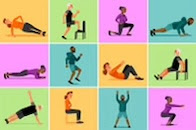Living an active life is important to staying healthy. Staying active helps to reduce your risk of conditions like heart disease, diabetes, and stroke. Exercise has also been linked to improved mental health and cognitive function. If you haven’t been active in several years, start out slow. Always talk to your doctor before starting an exercise program, as there may be precautions you should take. In general, you’ll want to start out with sessions of only five or 10 minutes. You can gradually increase the length of your sessions over time. If you’re unable to walk, you can still exercise. Try a chair exercise video, have someone help you with water aerobics in a pool, or play catch with someone from your chair. Throw in some strength training exercises to strengthen your bones and improve your balance, and you’ll be well on your way to a healthy lifestyle.
Ways to boost your activity level.
Grab the leash and walk your dog.
Your body and your pooch will thank you! Take your kid (or your spouse) for a walk. It’s an excellent way to get some face time without ex azz screens. Keep it fun by exploring new neighborhoods or turning your walk into a scavenger hunt.
Get Active.
Retrain your inner couch potato. Walk or jog in place, do yoga or lift weights, or walk on the treadmill at the gym while you watch your must-see TV shows.
Take the stairs.
The elevator may go up but it doesn’t make your heart rate climb. Take the stairs when you can, even if just for a floor or two. And don’t ride the escalator climb it. Those can be active steps, too!
Make it social.
Involve your family and friends. Physical activity is good for them, too. Plan fun physical activities that allow you to spend quality time together and stay on track. Meet a friend for workouts or train together for a charity event. Join a class or sports league where people count on you to show up.
Have more sex!!
Yup, you’re welcome. Some older research states that sex burns calories at a rate of about 3.1 calories per minute for women and about 4.2 calories for men. So although it’s not the same as a vigorous jog, you can (for sure) work up a sweat during sex. Have fun, try new positions and techniques, and bond with your partner all while moving more.
How much exercise do you need?
The key thing to remember about starting an exercise program is that something is always better than nothing. Going for a quick walk is better than sitting on the couch; one minute of activity will help you lose more weight than no activity at all. That said, the current recommendations for most adults is to reach at least 150 minutes of moderate activity per week. You'll get there by exercising for 30 minutes, 5 times a week. Can't find 30 minutes in your busy schedule? It's okay to break things up. Two 15-minute workouts or three 10-minute workouts can be just as effective.
Do strengthening activities twice per week.
Activities that make you push or pull against something may improve your strength and balance. Build and maintain bone and muscle strength. To help strengthen your whole body, work all major muscle groups, including those in your legs, back, abdomen, chest, shoulders, and arms. Doing 2 to 3 sets for each muscle group twice per week may help. Even 1 set of strength training offers benefits.
